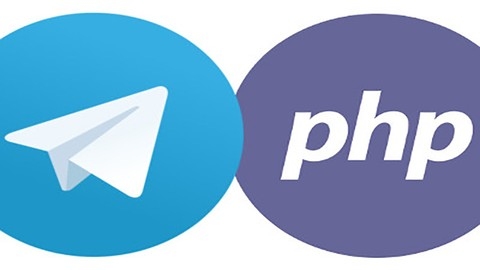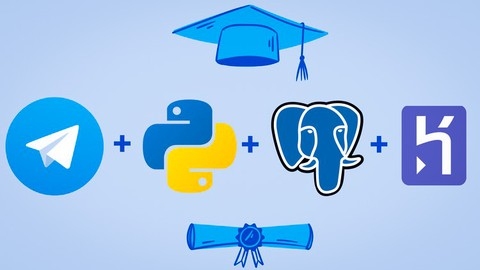Telegram bots have revolutionized the way businesses and individuals interact online.
These automated programs, hosted on the Telegram platform, can perform a variety of tasks, from providing customer support and sending notifications to delivering news updates and even playing games.
Learning how to create your own Telegram bot can open up exciting opportunities for automating tasks, enhancing communication, and building engaging experiences for your audience.
Finding the right course to guide you through the process of creating a Telegram bot can be challenging, with a plethora of options available online.
You’re searching for a comprehensive course that not only covers the fundamentals but also provides hands-on experience in building a fully functional bot.
You want a course that’s engaging, well-structured, and taught by an experienced instructor who can guide you through the intricacies of bot development.
Based on our in-depth analysis, we’ve identified Full Stack Telegram Bot from Scratch(Python + PSQL + Heroku) as the best overall Telegram course on Udemy.
This course offers a complete journey, starting with the basics of creating a Telegram bot and progressing to building a full-stack application using Python, PostgreSQL, and Heroku.
It covers essential aspects like database integration, deployment, and even advanced topics like migrating to newer versions of the Telegram API.
However, we understand that different learners have different preferences and needs.
That’s why we’ve compiled a list of other exceptional Telegram courses on Udemy, catering to various learning styles and focusing on specific aspects of bot development.
Continue reading to discover the perfect course to embark on your Telegram bot creation journey!
Full Stack Telegram Bot from Scratch(Python + PSQL + Heroku)
The course starts by teaching you how to create and configure a Telegram bot that can respond to messages.
You’ll learn about the Telegram bot platform, how to create a bot using BotFather, and how to set up your development environment with PyCharm and the python-telegram-bot module.
From there, the course dives into Python basics, covering topics like data types, flow control, functions, and classes.
This is optional, but it provides a solid foundation for those new to Python.
After a quiz to reinforce your understanding, you’ll start building the core functionality of your bot.
You’ll learn how to add reply keyboards, create conversation handlers for adding reminders and entering messages, and store reminders in memory.
The course then introduces you to threads and background tasks, which you’ll use to fire reminders when the time comes.
Next, you’ll connect your bot to a PostgreSQL database.
The course covers PostgreSQL statements, setting up a database and user, and implementing a DataSource class to work with the database.
You’ll refactor your code to store reminders in the database instead of memory.
Once your bot is fully functional, the course guides you through deploying it to Heroku.
You’ll learn about deployment, configure GitHub for pushing changes, create a Heroku app, set up the PostgreSQL add-on, and make your bot work on the server.
The course also covers Heroku logs and dataclips for monitoring your bot.
Finally, the course explores ways to improve your bot, including migrating from python-telegram-bot v13 to v20 and applying the necessary code changes.
Complete course TelegramBot and PHP, Build your ChatBot
This course equips you with the knowledge and skills to build your own Telegram chatbot from scratch using PHP.
You start with the fundamentals, installing essential tools like PHPStorm and using the Telegram Botfather to create your bot.
You learn the basics of PHP, including syntax, variables, arrays, conditional statements, loops, and functions.
The course then dives into working with databases, teaching you how to create, read, update, and delete data (CRUD) using PHP.
You’ll master the Telegram Bot API and Webhooks to create and configure your bot.
You learn to send and receive messages, photos, videos, and other media using PHP.
You discover how to use JSON for data handling and create interactive user experiences using various keyboard types, like ‘Inline Keyboards’, ‘Reply Keyboards’, and the ‘Oncetime Keyboard’.
You’ll build a ‘Random File’ project and learn techniques like ‘Disable Web View’ for specific bot interactions.
The course then challenges you with more complex projects.
You learn how to build a complete registration system, create a file store or music store bot, and develop a full-fledged ‘Inline Bot’.
You work with groups and channels, manage user roles with ‘GetChatAdministrations’, and implement features like a ‘Help Button’, search functionality with ‘Search Text’ for your ‘Music Store’, and a robust ‘Admin Panel’ for managing your bot.
You even learn advanced techniques like creating ‘Nested Menus’ with ‘HomeBack Buttons’ and managing user steps within the chatbot flow.
ESP32 + Telegram: Get Real-time notification for FREE
This course equips you with the knowledge and skills to harness the power of ESP32 and Telegram for real-time notifications.
You will start by setting up your development environment, familiarizing yourself with the ESP32 board, Arduino IDE, and Fritzing.
You will then dive into the world of Telegram bots, learning how to create one specifically for your IoT projects.
The course then guides you through connecting your ESP32 to various sensors, including analog sensors and touch sensors.
You will learn how to write code to read data from these sensors and send it to your Telegram bot.
For instance, you can program your ESP32 to send you a notification if the temperature measured by a sensor exceeds a certain threshold.
You will then explore the fundamentals of ESP32 programming, working with LEDs, analog and PWM signals, and even controlling a servo motor.
You will gain a solid understanding of how to control different electronic components, opening up a world of possibilities for your projects.
The course culminates in a comprehensive project where you apply everything you’ve learned.
This hands-on experience allows you to solidify your understanding and build a practical application.
You will emerge from this course with the ability to create your own sophisticated IoT projects, leveraging the power of ESP32 and Telegram for real-time feedback and control.
Create Telegram Bot with Python and Aiogram
This course teaches you how to build your own Telegram bots using Python and the Aiogram library.
You’ll start with the basics: creating and configuring your bot.
You’ll then learn to build an Echo Bot, a simple bot that sends back any message it receives.
This acts as a foundation for more complex bots you’ll create later in the course.
You’ll then discover how to use Command Filters, Content Type Filters, and User Filters to program your bot to respond to specific commands and user interactions.
You’ll explore various ways to send different media types, like photos, videos, documents, and even stickers, to create a rich, engaging experience for your users.
As you progress, you’ll learn to build interactive menus within your bot using inline and reply keyboards.
You’ll dive into more advanced concepts like Middleware, which helps streamline your code, and State Machines, a powerful tool for managing complex bot interactions and user progress.
Finally, you’ll discover how to integrate a database with your bot using Middleware, enabling your bot to store and manage data for a more personalized and sophisticated user experience.
Creating a telegram bot using Java
This course equips you with the skills to build a Telegram bot from the ground up using Java.
You begin by setting up your development environment and grasping the fundamentals of bot creation.
The course then delves into the world of Telegram bot features, teaching you how to send messages with formatting, create interactive experiences using reply and inline keyboards, and even edit messages for dynamic interactions.
You also explore the capabilities of inline requests, including practical implementations with InlineQueryResultPhoto.
The journey progresses to building a fully functional “Taboo” bot, a classic party game.
This practical project guides you through connecting your bot to a database, managing game entities like cards and players, and implementing the core game logic.
You learn to handle user commands like “Rules” and “Play”, upload dictionaries and cards for the game, and create a waiting room for players.
The course meticulously walks you through the development of a complete game experience, solidifying your understanding of bot development concepts.
Finally, you learn how to deploy your creation to the real world using AWS EC2.
This crucial step involves utilizing tools like BotFather for managing your bot’s metadata and ensuring a smooth deployment process.
You gain practical experience in preparing your bot for a live environment, making it accessible to a wider audience.





